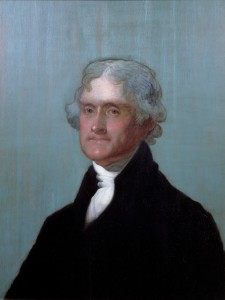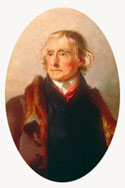Physical Descriptions of Jefferson
1781-1824. (Isaac Granger Jefferson, enslaved blacksmith at Monticello). "Mr Jefferson was a tall straight-bodied man as ever you see, right square-shouldered: nary man in this town [Petersburg] walked so straight as my Old Master: neat a built man as ever was seen in Vaginny .... a straight-up man: long face, high nose.[1]
1790. (William Maclay). "Jefferson is a slender man; has rather the air of stiffness in his manner; his clothes seem too small for him; he sits in a lounging manner, on one hip commonly, and with one of his shoulders elevated much above the other; his face has a sunny aspect; his whole figure has a loose, shackling air."[2]

Gilbert Stuart Portrait of Jefferson, 1805. National Portrait Gallery and Thomas Jefferson Foundation, Inc.
1801-09. (Samuel Harrison Smith). "The stature of Jefferson was lofty and erect; his motions flexible and easy; neither remarkable for, nor deficient in grace; and such were his strength and agility that he was accustomed in the society of children ... to practise feats that few could imitate."[3]
1802. (William Plumer). " ... a tall, highboned man ...."[4]
1806-22. (Edmund Bacon, overseer at Monticello). "Mr. Jefferson was six feet two and a half inches high, well proportioned, and straight as a gun barrel. He was like a fine horse — he had no surplus flesh. ... His countenance was always mild and pleasant."[5]
1807. (Sir Augustus John Foster). "... appearance being very much like that of a tall large-boned farmer."[6]
1808. (Frances Few). "... he is a tall thin man not very dignified in his appearance ... his face is short and his nose and chin approach each other — his teeth are good he shews but little of them when he laughs — he stoops very much but holds his head high ...."[7]
1809-26. (William Wirt). "... a strong and sprightly step ... the tall, and animated, and stately figure ...."[8]
1815. (Francis Calley Gray). "His figure bony, long and with broad shoulders, a true Virginian."[9]
1816. (Francis Hall). "I found Mr. Jefferson tall in person, but stooping and lean with old age, thus exhibiting that fortunate mode of bodily decay, which strips the frame of its most cumbersome parts, leaving it still strength of muscle and activity of limb."[10]
1816. (George Flower). "Mr. Jefferson's figure was rather majestic: tall (over six feet), thin, and rather high-shouldered; manners, simple, kind, and courteous. His dress, in color and form, was quaint and old-fashioned, plain and neat — a dark pepper-and-salt coat, cut in the old quaker fashion, with a single row of large metal buttons, knee-breeches, gray-worsted stockings, shoes fastened by large metal buckles — such was the appearance of Jefferson when I first made his acquaintance, in 1816."[11]
1820. (Isaac Briggs). "His 77th year finds him strong, active, and in full possession of a sound mind. He rides a trotting horse and sits on him as straight as a young man."[12]
1820. (Adam Hodgson). "Mr. Jefferson's appearance is rather prepossessing. He is tall and very thin, a little bent with age ...."[13]
1822. (Reverend S. A. Bumstead). "... his hair is quite thick ... his features regular .... He was remarkably erect and had every appearance of antiquity about him."[14]
1822. (D. P. Thompson). "Mr. Jefferson — a tall, straight, sandy-complexioned man ...."[15]
ca. 1822. (Judith Walker Rives). "... his tall figure had lost none of its uprightness."[16]
1823. (Alexander H. H. Stuart). "... raw boned man, with rather large hands ...."[17]
1824. (Daniel Webster). "Mr. Jefferson is now between eighty-one and eighty-two, above six feet high, of an ample, long frame, rather thin and spare. His head, which is not peculiar in its shape, is set rather forward on his shoulders; and his neck being long, there is, when he is walking or conversing, an habitual protrusion of it. It is still well covered with hair, which having been once red, and now turning gray, is of an indistinct sandy color. His eyes are small, very light, and now neither brilliant nor striking. His chin is rather long, but not pointed. His nose small, regular in its outline, and the nostrils a little elevated. His mouth is well formed and still filled with teeth; it is strongly compressed, bearing an expression of contentment and benevolence. His complexion, formerly light and freckled, now bears the marks of age and cutaneous affection. His limbs are uncommonly long; his hands and feet very large, and his wrists of an extraordinary size. His walk is not precise and military, but easy and swinging. He stoops a little, not so much from age as from natural formation. When sitting, he appears short, partly from a rather lounging habit of sitting, and partly from the disproportionate length of his limbs. ... His general appearance indicates an extraordinary degree of health, vivacity, and spirit."[18]
1824. (Samuel Whitcomb, Jr.). "He is tall and very straight excepting his neck which appears limber and inclined to crook. His hair is long and thin."[19]
Ante 1826. (George Tucker). "In person he was above six feet high, thin and erect."[20]
- Zanne Macdonald, 7/92
References
- ^ Isaac Jefferson, Memoirs, 21.
- ^ Willliam Maclay, Journal of William Maclay, United States Senator from Pennsylvania, 1789-1791, ed. Edgar S. Maclay (New York: D. Appleton and Co., 1890), 272.
- ^ Samuel Harrison Smith, Memoir of the Life, Character, and Writings of Thomas Jefferson (Washington: S.A. Elliott, Printer, 1827), 35.
- ^ William Plumer to Jeremiah Smith, December 9, 1802, quoted in Lynn W. Turner, William Plumer of New Hampshire, 1759-1850 (Chapel Hill: Published for the Institute of Early American History and Culture, Williamsburg, Va., by University of North Carolina Press, 1962), 94.
- ^ Hamilton W. Pierson, Jefferson at Monticello: The Private Life of Thomas Jefferson (New York: Charles Scribner, 1862), 70-71. See Bear, Jefferson at Monticello, 71.
- ^ Augustus John Foster, Jeffersonian America: Notes on the United States of America (San Marino, CA: Huntington Library, 1954), 10.
- ^ Noble E. Cunningham, ed., "The Diary of Frances Few, 1808-1809," Journal of Southern History 29, no. 3 (1963): 350.
- ^ "Biography of William Wirt," in William Wirt, The Letters of the British Spy (New York: J. & J. Harper, 1832), 76.
- ^ Francis Calley Gray, Thomas Jefferson in 1814, Being an Account of a Visit to Monticello, Virginia (Boston: The Club of Odd Volumes, 1924), 67.
- ^ Francis Hall, Travels in Canada, and the United States, in 1816 and 1817 (London: Printed for Longman, Hurst, Rees, Orme, & Brown, 1818), 374-75.
- ^ George Flower, History of the English Settlement in Edwards County, Illinois: Founded in 1817 and 1818, by Morris Birkbeck and George Flower (Chicago: Fergus Printing Company, 1882), 43.
- ^ Isaac Briggs to Hannah Briggs and Children, November 21, 1820, Isaac Briggs Notebook, Accession #38-530, Special Collections, University of Virginia Library, quoted in Peterson, Visitors, 90.
- ^ Adam Hodgson, Letters from North America Written During a Tour in the United States and Canada (London: Printed for Hurst, Robinson, & Co., and A. Constable, Edinburgh, 1824), 318.
- ^ S.A. Bumstead to "Aunt Lilly," August 23, 1822, quoted in "A Description of Jefferson," The Virginia Magazine of History and Biography 24, no. 3 (1916): 310.
- ^ D.P. Thompson, "A Talk with Jefferson," Harper's New Monthly Magazine XXVI (1863): 833.
- ^ Autobiography of Judith Walker Rives, Rives-Troubetzkoy Papers, Accession #2313, Special Collections, University of Virginia Library, quoted in John Hammond Moore, Albemarle, Jefferson's County, 1727-1976 (Charlottesville: Published for the Albemarle County Historical Society by the University Press of Virginia, 1976), 152.
- ^ Alexander H.H. Stuart to W.J. Campbell, August 3, 1886, American Philosophical Society.
- ^ Daniel Webster, The Private Correspondence of Daniel Webster, ed. Fletcher Webster (Boston: Little, Brown and Company, 1857), 364-65.
- ^ Samuel Whitcomb, Jr., "An Interview with Thomas Jefferson," May 3, 1824, Accession #2816, Special Collections, University of Virginia Library, quoted in Peterson, Visitors, 95.
- ^ George Tucker, The Life of Thomas Jefferson, Third President of the United States (London: C. Knight, 1837), 565.
